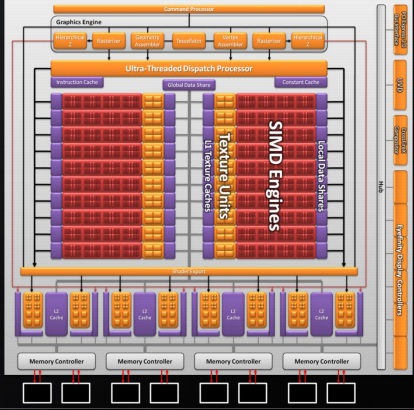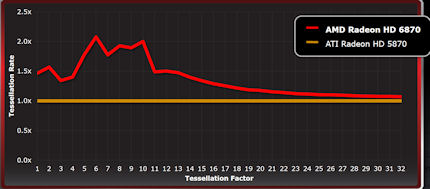Architecture, plus improvements in tessellation and IQ
What you should have picked up by now is that AMD and its partners are releasing the Radeon HD 6850 and HD 6870 GPUs. Both may well end up being slower than incumbent Radeon HD 5850 and HD 5870 GPUs, but that's a marketing-lead problem more than a technical issue, as they're designed to populate different parts of the market.The guts of the two new GPUs - Radeon HD 6850 and HD 6870 - can be best-explained by trotting out the block diagrams. First off, here's a high-level overview of the Radeon HD 6870.
Compare this with the same high-level view of the Radeon HD 5870.
 Radeon
HD 5870
Radeon
HD 5870Take a long, hard look at the two and play the spot-the-difference game. The architectural layouts on both are largely the same. This means they're both DX11 GPUs composed of geometry setup, thread dispatch on to a huge number of same-type SIMD cores, post-processing through 32 ROPs connected to a 256-bit memory bus, and out to GDDR5 memory.
The key takeaway here is that AMD hasn't made obvious changes to the core; the SIMD engines are seemingly identical. That said, the time-gap between the generations enables AMD to massage the architecture in subtle ways for extra speed - critical path analysis being an obvious example. But it's easier to point out the differences than the similarities, though.
Boosting geometry throughput - improve the hardware tessellator
The first indication that we're looking at a new architecture and not just a cleaved-down version of Radeon HD 58x0 presents itself in the innocuous 'Tessellator' rectangle at the top. As you may know, DX11 enables games developers to tap into the fixed-function tessellation engine - which enables, amongst other goodies, the ability to turn low-polygon models into high-polygon jobbies through the help of what are known as programmable hull and domain shaders - and produce more geometrically-accurate objects.
Appreciating that NVIDIA's GeForce GTX 400-series of cards are especially strong in this area, Radeon HD 6850/70's tessellation engine has been overhauled and optimised between generations.
The 2x improvement at low-ish tessellation factors - which means the degree of tessellation - is made possible by two main additions to the Barts core: deeper buffering for the pre-tessellator hull shader and a revamp to provide significantly greater throughput for both pre- and post-tessellator shaders.
However, up the tessellation factor to unrealistic levels and the GPU becomes fundamentally limited by the processing of the vertex shader, which, in architecture terms, sits before the combo of hull, tessellator and domain. This is why the Radeon HD 6800-series shouldn't be much faster than present Radeon HD 5800 in these extreme tessellation cases; it simply cannot get data to the tessellator and shaders fast enough. Got all that?
Image quality - AA and AF
It wouldn't be a GPU launch if a 'new' antialiasing mode didn't make the cut. To this end, AMD is introducing what's termed morphological AA (MLAA). This is provided by way of a post-processing algorithm that's accelerated by DirectCompute, and it works by looking at the full scene and noting patterns of jaggies - the old staircase effect - by interrogating colour and depth information in order to find contrasting edges. Once these patterns have been noted, MLAA then blends the pixels around them to smooth out the image. Nothing really new here, right?
MLAA, though, is reckoned to provide the same level of AA quality as running 4-8x multi-sampled AA (MSAA), but because it runs on the GPU via DirectCompute, after each frame has been rendered rather than during the frame compilation itself, as with traditional multi-sampled AA, the new antialiasing mode is both faster and uses a significantly smaller memory footprint. This means that the performance degradation by dialling in AA isn't as large as with MSAA.
The premise behind MLAA idea is to have fast, computationally cheap, high-quality AA. That's the theory, anyway. The downside is that the post-processing can only work on the pixels already rendered, meaning that any sub-pixel aliasing isn't possible. AMD will bring morphological AA to a special Catalyst 10.10a driver, we believe, and there's little reason why MLAA shouldn't run on existing Radeon 5-series hardware through the same driver update.
AMD also claims to have cleaned the anisotropic filtering from the transition between series. The Radeon 5800's AF was good, but, funnily enough, AMD now readily admits that it wasn't fantastic when moving between different AF levels. This is now improved in the HD 6800 cards, but having run the 3DCenter Filter Test and pored over the results, it's difficult to see the difference(s) unless you're being fastidious.











